Oral History: The Wire's East-West Showdown

On a sweltering day in the summer of 2002, some of Baltimore’s finest basketball players assembled for a game on the city's east side at Collington Square Park. It was something close to an All-Star contest. And millions of people would end up watching.
Fifteen years ago, The Wire debuted on HBO. The highly acclaimed series, which spanned five seasons from 2002 to 2008, depicts the decline of the American city, told through a fictionalized reality of Baltimore. The story is often defined by loss—of life, industry, opportunity and institutions.
In 1973, Baltimore lost something else: the NBA, when the Bullets moved to Washington. But basketball continues to thrive in Charm City. It’s a pillar of the town that molded Carmelo Anthony, Keith Booth, Michael Lloyd, Skip Wise, Sam Cassell, Muggsy Bogues and so many other great players. Without basketball, the story of Baltimore would feel incomplete.
The Wire’s ninth episode, “Game Day,” brings the police detail’s investigation of the notorious Barksdale organization to the basketball court, where rival drug dealers from the east and west side preside. This is the oral history of how The Wire’s hoops game unfolded, and how just a few minutes of on-screen gameplay managed to authentically portray Baltimore’s rich culture of basketball.
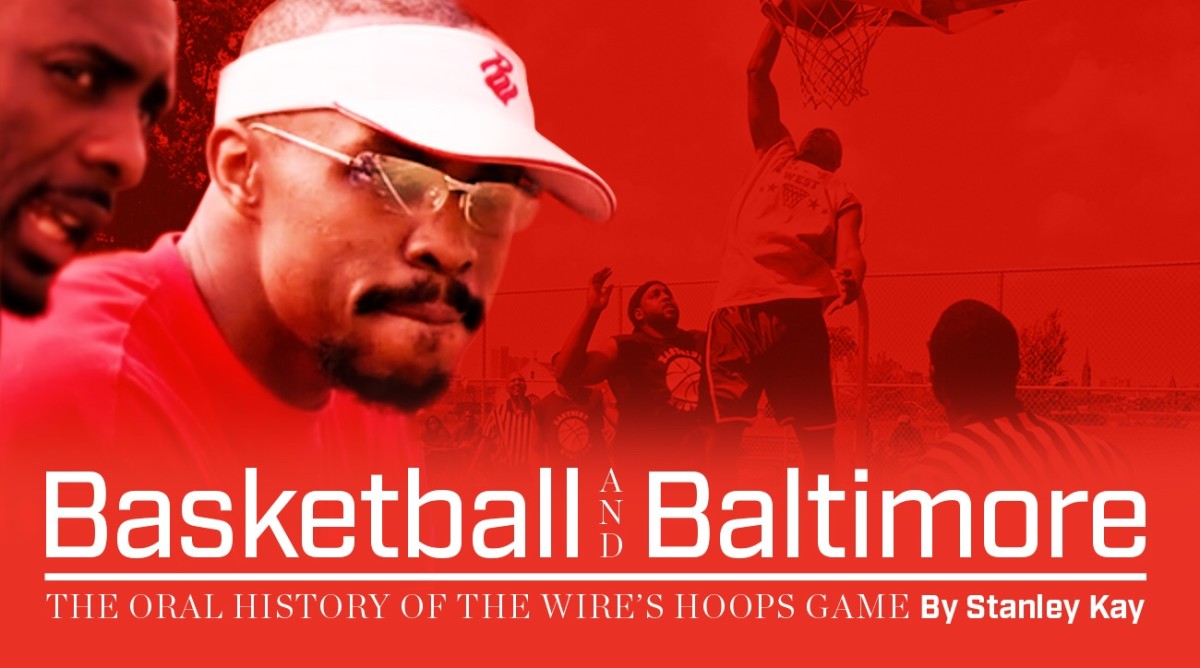
CHRISTOPHER CLANTON (Savino Bratten): Baltimore is known for heroin as well as basketball. You already have the storyline of drug dealers, the typical cliche with a twist hood story. With Baltimore, you had no other choice but to involve the basketball aspect.
DAVID SIMON (creator): We wanted to do something with the natural competition between east side and west side.
DAVID MELNICK (writer): This east side vs. west side thing was a really unique and new dynamic for the show, something the show hadn’t seen yet.
DAVID SIMON (creator): I just remember once we found it, we were like, yeah. This feels right. This feels like the way in which we’re going to do this.
DAVID MELNICK (writer): I think sports is, and basketball in particular, is a big part of the culture of Baltimore, going back to the early 80’s with the amazing Dunbar team that people still speak about incredibly fondly as perhaps one of the greatest high school teams of all time, with Muggsy Bogues. I think basketball is an important part of the culture that helps tell that story. And I think it became a refreshing way to help introduce this rivalry that would eventually grow and build without having to hit you over the head right away that this is going to be intense.
SHAMIT CHOKSEY (writer): Most of the time when sports are written for TV and film, it’s just a regurgitation of what we’ve seen before. I think there are plenty of great examples of sports too, in film and TV. But it happens when the filmmaker and the writer and the director kind of departs from what we know about that sport and shows a new side of it. I think the East–West basketball game was sort of […] a new structure to see basketball.
MILCHO MANCHEVSKI (director): I still play basketball, but I played for a team back in Yugoslavia back when I was in high school. I think I must have told Bob [Colesberry, one of The Wire’s co-creators] that I liked basketball so much, so that’s why he picked that episode. But yeah I was over the moon that I got to direct basketball.
DAVID SIMON (creator): It’s a populist triumph of sport, basketball in the city. A city game. It felt right. You can’t imagine us doing that with football—nothing would be right. Baseball would be absurd. But even football would feel a little bit too much like the football game at the end of M*A*S*H. This felt organic to the actual city in which we all lived. The city of Dunbar, ‘Melo and the old love of the Bullets in the Civic Center. It’s one of the original NBA cities, even if it doesn’t have an NBA team anymore.
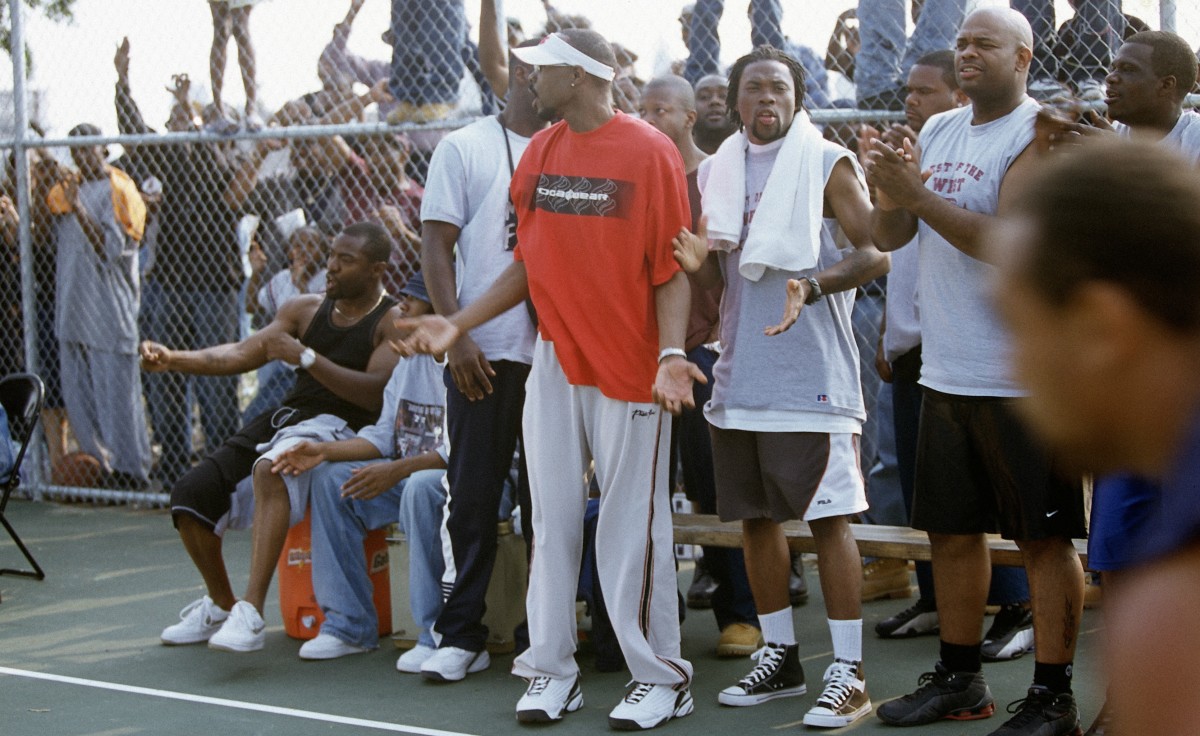
DAVID MELNICK (writer): Herc and Carver are sitting on the roof and nobody’s around.
SHAMIT CHOKSEY (writer): They’re looking around and there’s nobody out on the streets. They’re up on a roof, they’re doing surveillance, and one of them says to the other one, “Maybe we won.”
DAVID MELNICK (writer): There’s this war on drugs and the war on the neighborhood, and there’s this notion that there’s two different sides battling each other. In a way, the whole team concept that came up through the basketball part of our show—it’s this “maybe we won.”
MILCHO MANCHEVSKI (director): I tried to see the whole game sort of from a voyeuristic point of view, from an outsider’s point of view, because the two agents who come in—they’re dropped in the middle of it, so they’re outsiders and a little confused. Until they realize what’s going on.
TRAY CHANEY (Malik “Poot” Carr): I remember that day real clear. It was a nice sunny day.
CHRISTOPHER CLANTON (Savino): It was hot. It was a beautiful day in Baltimore. And they were pretty much in the heart of East Baltimore. It was at Collington Square basketball court. So with the hired extras there was still atmosphere. People were coming from everywhere, all walks of life, to watch what was going on.
J.D. WILLIAMS (Bodie Broadus): That was pretty early on in the series, and we hadn’t had a lot of time to get to know the city or its legends like that. But I do remember that day on the court, for what it was, and it was high energy from good players.
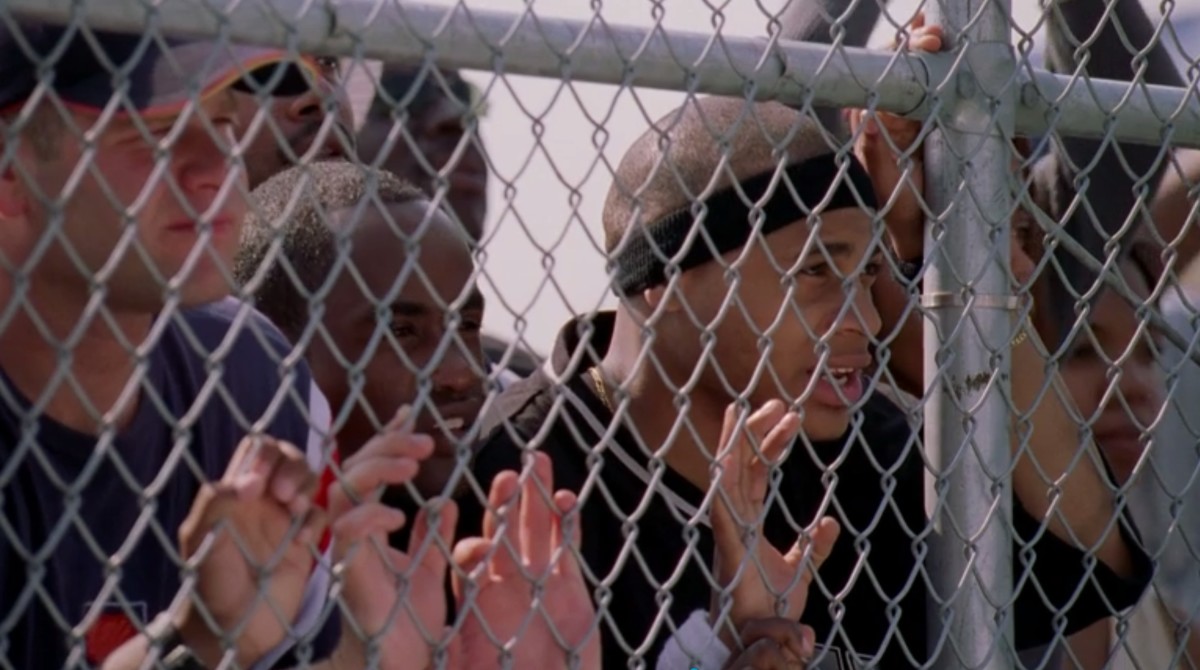
MILCHO MANCHEVSKI (director): It was important to create the feeling of community, the environment. So I spent a lot of time trying to get believable extras, and came up with some of the people bringing lounge chairs to watch the game and they’re like walking away with the chairs, so just to give a little real life feel to it.
PAT MORAN (Baltimore casting director): Here’s who watched that show: People that read The New York Times, law enforcement, criminal element…basically these are our core audience. People that were in that life. People that had escaped that life. People that had the tragedy of addiction come barreling through their life, all kinds of things.
So it had to be authentic. If you even had one component wrong, it’s going to kill the scene.
ANTHONY HEMINGWAY (first assistant director): We had put out an emergency request on the radio that day to raffle off prizes for people to come participate in the scene. And so we had a lot of background who were there because they loved the show, and they wanted to be in the scene and then they were there for the prizes. And I knew they would not be there or stay around very long.
J.D. WILLIAMS (Bodie): I think everybody, especially the Baltimoreans, they wanted the scene to succeed.
The Real Value Of 'The Best Player On The Floor'
ANTHONY HEMINGWAY (first assistant director): In every moment the entire five seasons, we employed a lot of people from the neighborhoods. This was a story that was very largely I think about the human condition and really spoke louder and beyond Baltimore, but we were making this show in Baltimore kind of about a lot of their specifics, so we wanted to use the people within. And Baltimore is a specific place that has a specific sound, and also a specific look when it comes to even the costumes and things.
DAVID MELNICK (writer): [Baltimore] wasn’t just the backdrop. It was a character in the story. So it was important for [David Simon] to make that as textured and as real as possible.
UTA BRIESEWITZ (director of photography): The players start playing and the extras start cheering, and they’re totally into the game with the stuff that they call out. And all of the sudden it becomes so real and authentic, and you feel like you are experiencing the real thing, but actually this is all created. To me, to this day, it always has an excitement where you have scenes where you bring people together, and especially people from that neighborhood who kind of behave in a completely natural way.
PAT MORAN (Baltimore casting director): The people that you saw playing ball were people who played ball in those situations in those neighborhoods.
CHRISTOPHER CLANTON (Savino): Some were prominent high school or college basketball players, and even streetball players that they had gotten to come in and pretty much put on a show.
SETH GILLIAM (Ellis Carver): They had gotten dudes from both the east side of Baltimore and the west side as ball players to be part of the game, to bring that kind of energy and that kind of attitude.
PAT MORAN (Baltimore casting director): You don’t need a professional actor necessarily for minimal dialogue. And certainly in a case like that, what you needed to do was to be able to play ball like you were playing ball if you were doing east side against the west side.
DAVID SIMON (creator): We put out feelers at Coppin [State] and Morgan [State] and wherever else in the area.
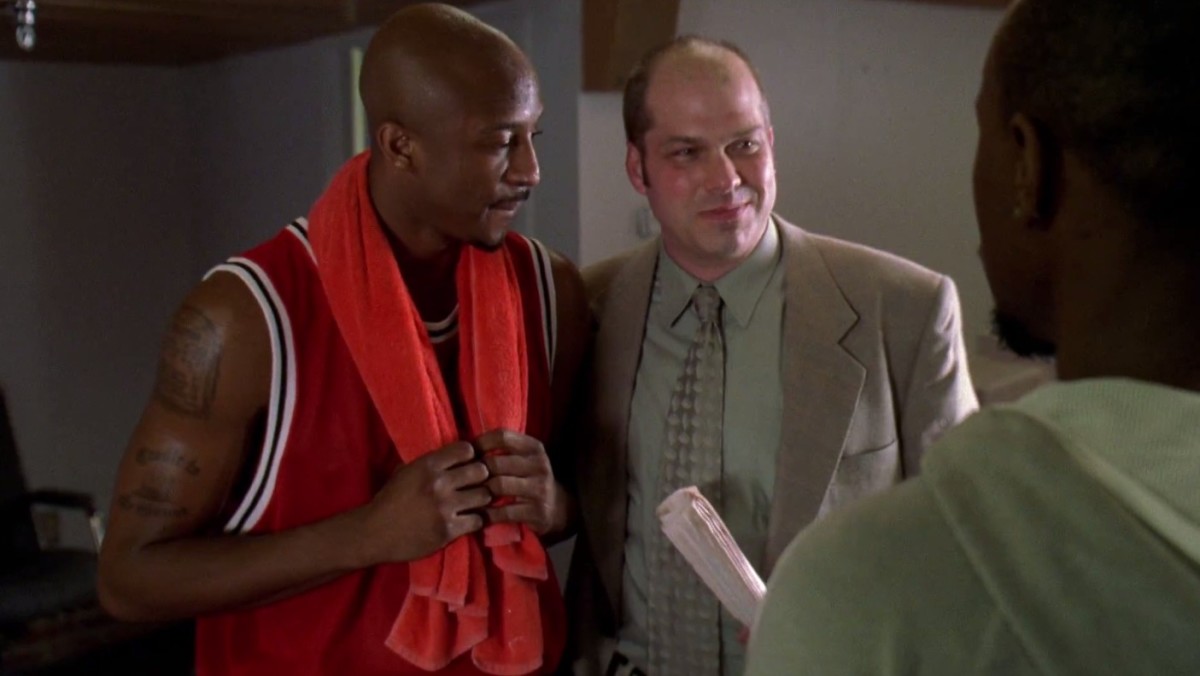
MAURICE BLANDING (Barksdale’s ringer): The story of The Wire is based out of Lexington Terrace Projects, and I also grew up in Lexington Terrace Projects. The director didn’t even know that when I got the job, and it’s crazy because the job was—basically it was a situation where I knew the security guy. He was like, “They’re looking for a basketball guy, and we need you to come and audition. You can get it.” And I’m like, alright cool, whatever. I didn’t think The Wire was going to be this big, but it was.
I went up to Coppin State, and the director was there. And he was like, “Well can you slam dunk?” And the ball was sitting under the rim…I took the ball just right off the ground and jumped straight up. I had like a 45-inch vertical back then, so I just threw it down. He said, “You’ve got the job.”
ANDRE “SILK” POOLE (Prop Joe’s ringer): Kwame Evans was a standout at George Washington, should have made the league, really. 6’7’’ shooting guard. He went to George Washington. […] Che Evans, he played down at Bowie State University. Bino [Ranson]. Maurice played overseas. So we had dudes who was legit. This wasn’t let’s go get the Wawa manager and the guy that works at the pizza shop and take them out to the court. This was like real basketball—dudes out there talking trash, the whole nine.
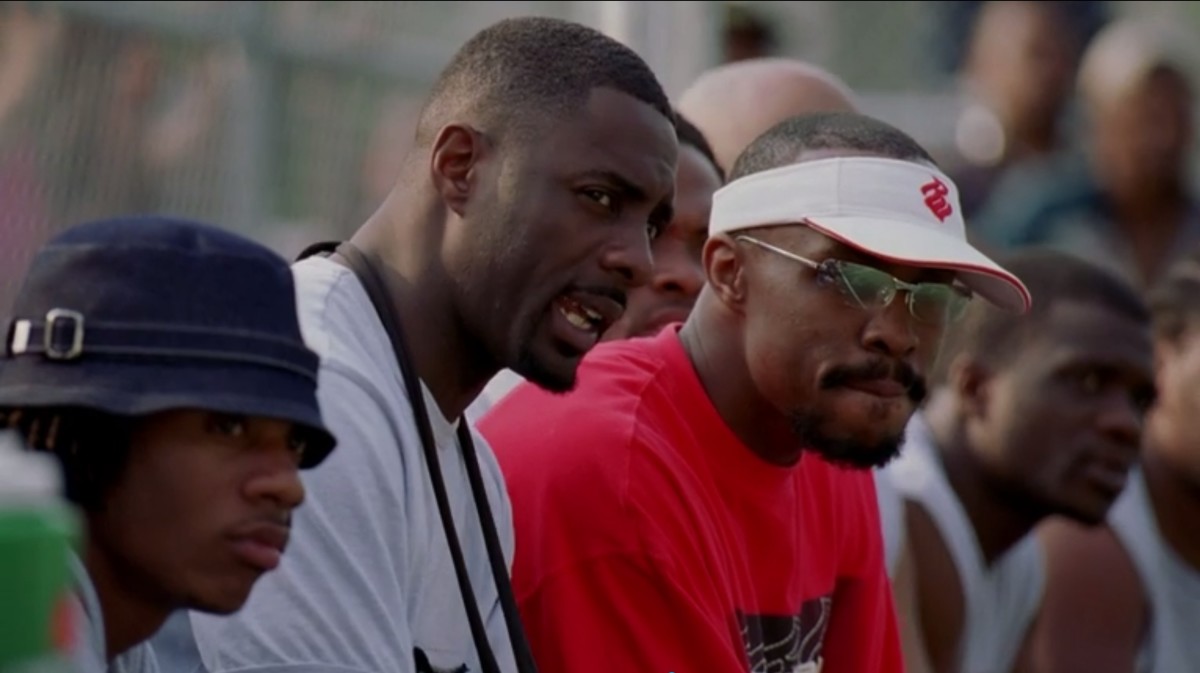
TRAY CHANEY (Poot): The game was dope.
CHRISTOPHER CLANTON (Savino): They put on a show for the extras and the rest of the cast that was there.
SETH GILLIAM (Carver): It didn’t look like plays had been set, it didn’t look choreographed. It looked like real people playing.
BINO RANSON (player): It was pretty cool because you had guys out there that could actually play. You were really just hooping. It was pretty cool, just to be there with Avon Barksdale and Wee-Bey, and to have those guys. Their job was really actors and our job was really basketball players. They were like in awe of our game.
ANDRE “SILK” POOLE (Prop Joe’s ringer): It’s hot out there, probably like 90 something degrees. And Collington Square Park sits on a hill, so we’re like all the way up, maybe 80, 100 feet up a hill. So the sun is beaming. You’ve got the asphalt, it’s hot. And we’re out there playing. Baltimore players, that’s what we do. We’re out there playing like for real.
PAT MORAN (Baltimore casting director): You cannot get kids going to Juilliard to interact like that.
J.D. WILLIAMS (Bodie): I actually did request to somehow be playing basketball in that scene, but it didn’t fit my character.
WOOD HARRIS (Avon Barksdale): I play basketball. So in between takes, I’m shooting the ball, I’m playing with the ball. Those other guys playing ball, I’m looking at them like, “You ain’t nobody. Come here, I got you.” All the down time is a lot of fun because we’re playing basketball.
MILCHO MANCHEVSKI (director): It was more like directing dance than directing film or television.
J.D. WILLIAMS (Bodie): It looked authentic.
BINO RANSON (player): We were just playing basketball, and then the producer or whomever they knew what they were looking for, so at times they would stop it and they would start again, stop it and start again.
UTA BRIESEWITZ (director of photography): When basketball or sports film can sometimes feel—I don’t even want to use the word inauthentic, but not like we are used to seeing it, it’s because the camera angles that are usually not possible. […] Which of course, can make it very exciting and cinematically very exciting, but it doesn’t really give you the viewing experience that would place you at that basketball game just being an observer, just standing behind that fence and watching like everybody else.
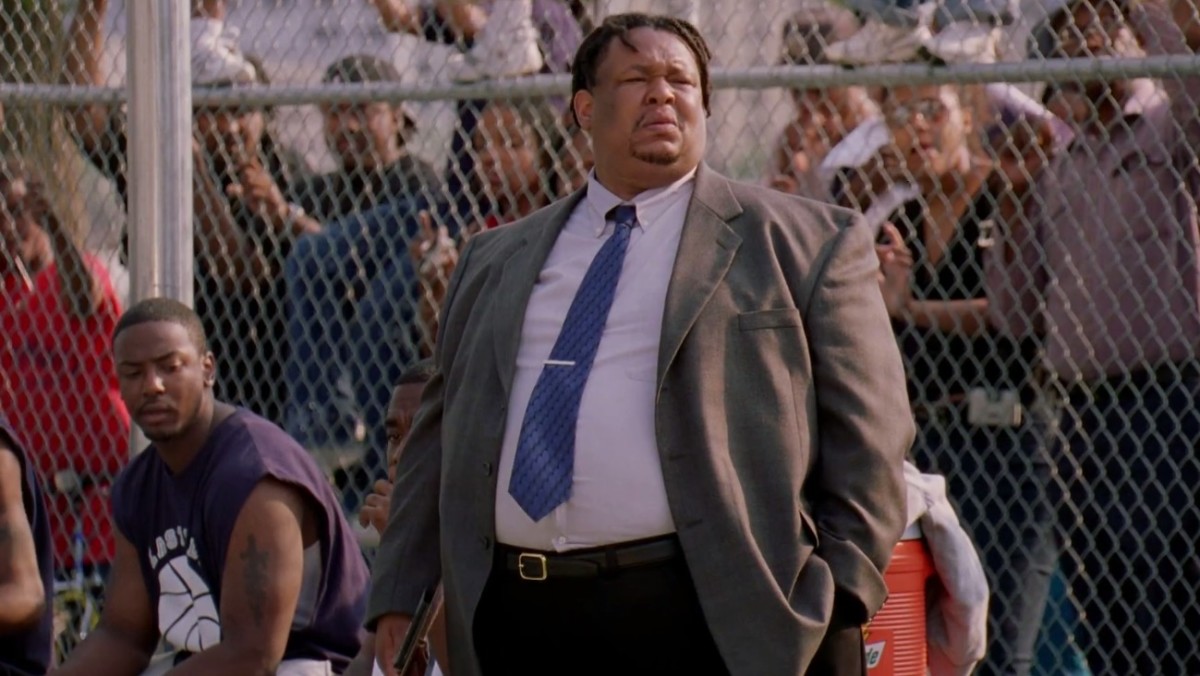
DAVID MELNICK (writer): We felt a lot of responsibility for introducing this character Proposition Joe, who truthfully we had no idea of the impact he was going to have over multiple seasons. But there’s a great sense of responsibility to introduce a new character. Those first couple moments on screen were really going to set the table for who this guy was and what his motivations were and what his approach was.
DAVID SIMON (creator): When I walked on set and saw Robert Chew there, it was like today is going to be a good day.
PAT MORAN (Baltimore casting director): Prop Joe was my guy.
UTA BRIESEWITZ (director of photography): It was very, very hot. And Robert F. Chew, who plays Proposition Joe, was really wearing the suit in that heat. And the other thing that I remember is that he never sat down. In between takes, he never sat down to rest or whatever, he was always up on his legs in that suit. And I thought oh my gosh, he must be close to fainting in this Baltimore heat.
WOOD HARRIS (Avon): An actor can show up and just have the lines memorized and be looking for the outcome of the scene, and that’s all very amateur. With me and Prop Joe, you’re not really seeing that. With none of the actors in The Wire, very rarely are you seeing disconnection. I was connected to him as a listener, he was connected to me as a listener, and we stayed in character the whole time.
TRAY CHANEY (Poot): I remember when, real clear, when Avon and Prop Joe were going back and forth, I was actually on the fence to witness that.
WOOD HARRIS (Avon): What are you, Pat Riley? You got a suit on? Get the f--- outta here. You got a clipboard?
DAVID SIMON (creator): That whole exchange was me. I felt like with a comic moment, Robert Chew was perfect. He didn’t oversell it. There’s a way of throwing away the punch line and throwing away the humor that makes it funnier. He was just such a good actor.
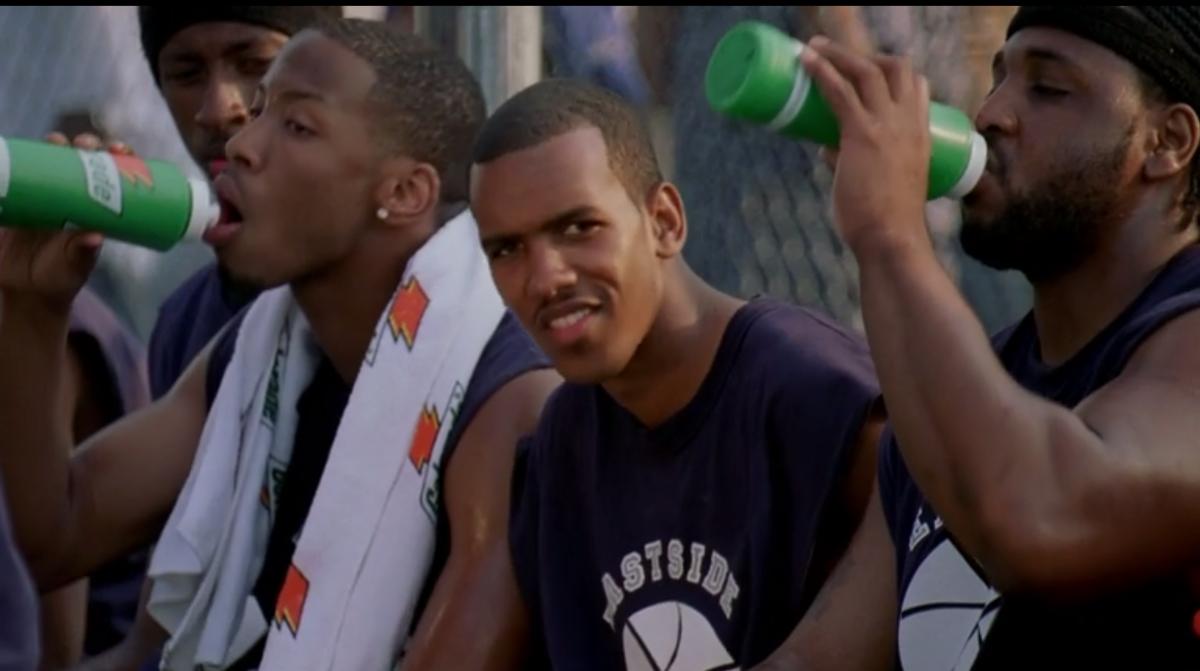
ANDRE “SILK” POOLE (Prop Joe’s ringer): Prop Joe was always trying to do something and move and get into position to kind of play both sides, but try to benefit without being seen. It was the same type of thing. And it kind of translated through that basketball scene.
DAVID MELNICK (writer): The idea of the one-upmanship with Avon and Stringer going to get their ringer, and then all the sudden Prop Joe pulls out his and kind of one-ups the West Side guys—that was a lot of fun to craft and to think about.
MAURICE BLANDING (Avon’s ringer): His name is Andre Poole. His name was Silk with And1. He was the guy who was the ringer for Prop Joe’s team, that came out with all the shaky move and everything. He could really play like that. That was legit. He was a beast.
DAVID SIMON (creator): He had this one unbelievable crossover. I remember when we saw him do that. We were like, that’s the sell. That sells the whole moment. That’s just such a great move.
ANDRE “SILK” POOLE (Prop Joe’s ringer): They kind of found me and was like look, we gonna put you on the bench until the second half. And in there Maurice, he’s going out, he’s doing his thing. And [Prop Joe’s] like “OK, how about you bet [six figures]?” And [Avon] says” OK bet it, bet it.” So he looks over at me like, OK yeah it’s time. Put him in. So I come in, I start doing my thing.
DAVID SIMON (creator): I thought that move that move that the guy made from the top of the key was just gorgeous. That was just gorgeous. All credit to Milcho on that.
BINO RANSON (player): That play where Silk hit me up… that was strictly for the cameras. I got paid for that.
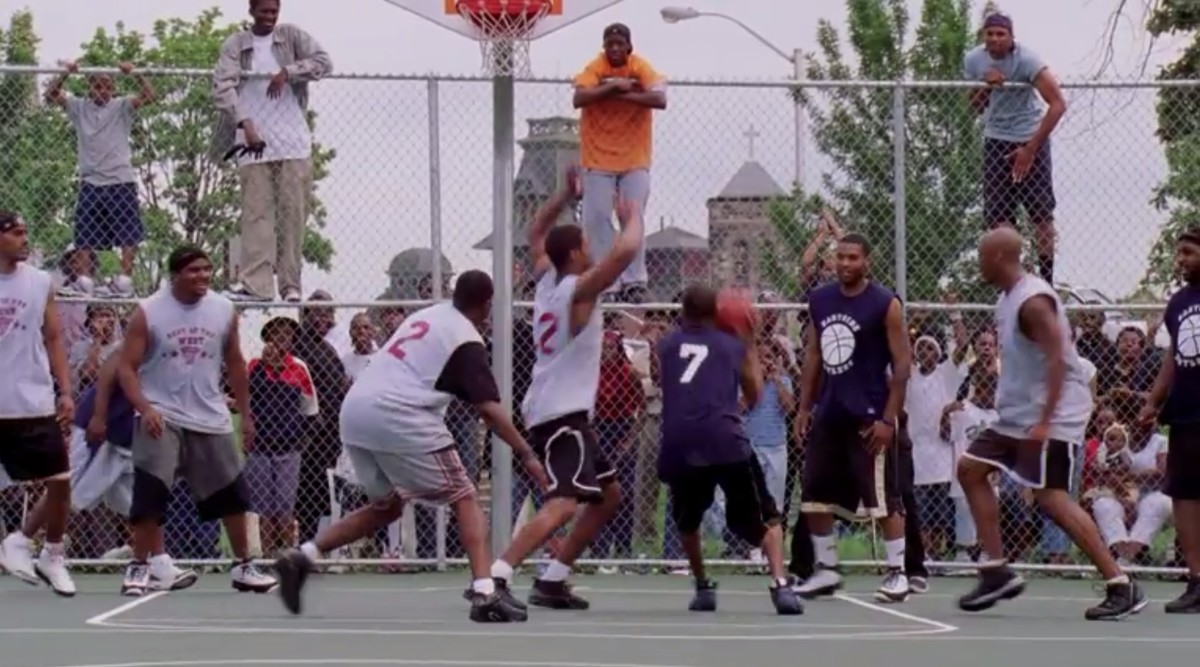
WOOD HARRIS (Avon): I think I go up to the referee, and he made a bad call and I’m just about the kill this dude.
DAVID SIMON (creator): [The game] served plot for a couple of reasons. It served the sort of competition between Prop Joe and the East Side and the Barksdales on the West Side. And […] the idea of the intimidated ref and then Barksdale becoming disgusted that he was intimidated gave you some sort of insight into Avon that we liked.
WOOD HARRIS (Avon): You can totally remember that guy’s face…He did a great job. He was so afraid of me. And I played off of it. So my bully energy was right in front of you on the screen. And he was so afraid of me. When I told him to turn around, it was just perfect—I thought he was afraid for real!
TRAY CHANEY (Poot): I was so starstruck at my brother Wood Harris, because I’ve been a fan of Wood Harris for a long time. Some of those lines that he was delivering reminded me of when he was in Above the Rim with Tupac.
J.D. WILLIAMS (Bodie): In that capacity, in that setting, just to be there with Wood Harris—he’s a phenomenal actor, and he brings something that no other actor brings to his roles. So I was just as much a spectator as I was a participant in the scene along with him.
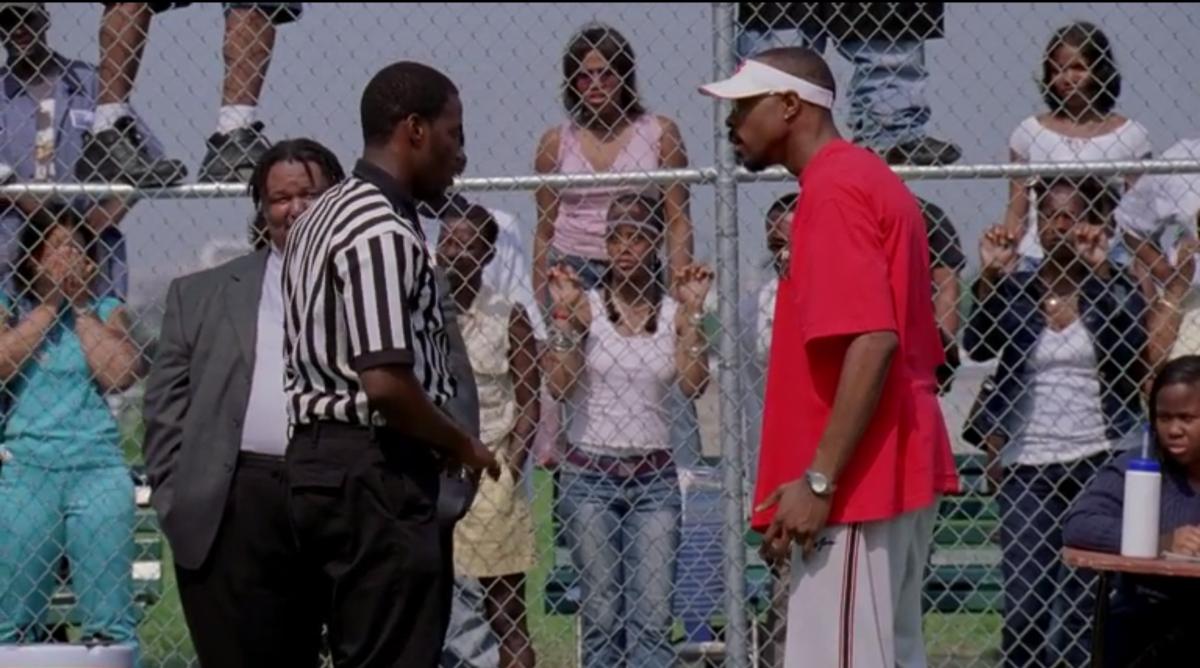
WOOD HARRIS (Avon): Basketball is my favorite sport. And I grew up in Chicago in similar, I would say, fashion as Baltimore as it relates to the urban settings. It was different in Baltimore than in Chicago, but at the end of the day you have that economic energy is the same—there’s no money. So I’ve been in playgrounds in the parks before where they’ve been taken over by the gangsters of the neighborhood, and I’ve played in those games before, basketball. So for me, being in the scene on the work day I connected to that part of my experience as a person. So I was kind of familiar with being on the basketball court and having a gangster or a gangbanger be presiding over a game or checking a coach or checking a player on the court or actually beating up somebody. I’ve seen those things happen on the basketball court, so for me it was fun, believe it or not, to be able to […] preside over the court and gangsterfy the park.
DAVID MELNICK (writer): [Sports] is a good storytelling device, but for us and for David’s vision, this is a character based show. So it’s how do the characters react to the action? How are the characters planning and plotting and moving forward as part of this scene? For Shamit and I it was, let’s make sure we’re not trying to write in every pass and every dunk and every moment unless it’s pivotal to progressing the story or character.
SETH GILLIAM (Carver): If there’s a commonality, a common event, opposing sides will come together for it. If there’s something they can find in common, they can put aside their differences, to share that commonality. And I think it was like a lightning bolt of, “what the f--- are you talking about?” to Herc and Carver, because they didn’t imagine anything more than just thugs. That they couldn’t exist outside of that kind of structure.
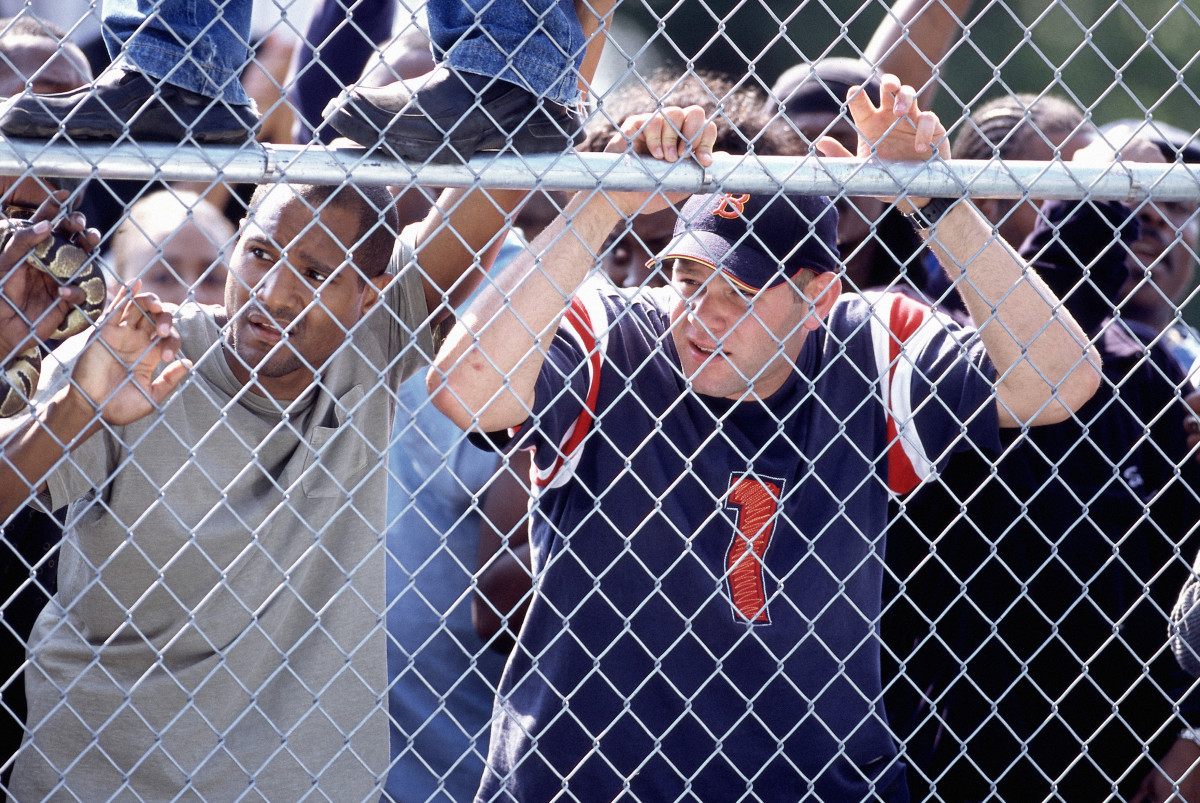
SHAMIT CHOKSEY (writer): If you look at the episode as a whole, basketball is sort of a backdrop. Even though it’s a thing that everybody remembers about the episode, it’s kind of just the glue that held the rest of it together.
WOOD HARRIS (Avon): It’s when the police first see Avon Barksdale. That’s what is pivotal about that episode. Prior to that episode, the police don’t even know what he looks like really. They can’t even really figure him out at all. And in spying on the game later on, they get to get a glimpse of Avon Barksdale.
DAVID SIMON (creator): [The game] created some drama around which you could write an awful lot of subtext: the idea of ringers being sort of standard M.O., the idea of Prop Joe having the same stature from the East Side as the Barksdales on the West Side when we had devoted a lot less time to him obviously as a supporting character. The idea of Barksdale’s intense pride being affronted. The idea of the rules themselves being vulnerable at any given moment. And then sort of the nuance of him pulling back in disgust at the idea that even the rules of this game, which he actually valued, were vulnerable—the business with the ref. The idea that Herc and Carver sort of were left in place, being sort of not the pieces that they wanted to do the actual surveillance, spoke to their position within the unit. It just accomplished a lot of stuff.
ANTHONY HEMINGWAY (first assistant director): For me, visually it was a moment that I just loved where we found this court that was in the middle of the city that was elevated, and you were able to see the whole city of Baltimore kind of 360 around it.
DAVID SIMON (creator): I do remember that when we looked at the film, the dailies, I felt like man that feels like real Baltimore. That feels right. Every time the camera panned, and there were so many nice touches that I was proud of.
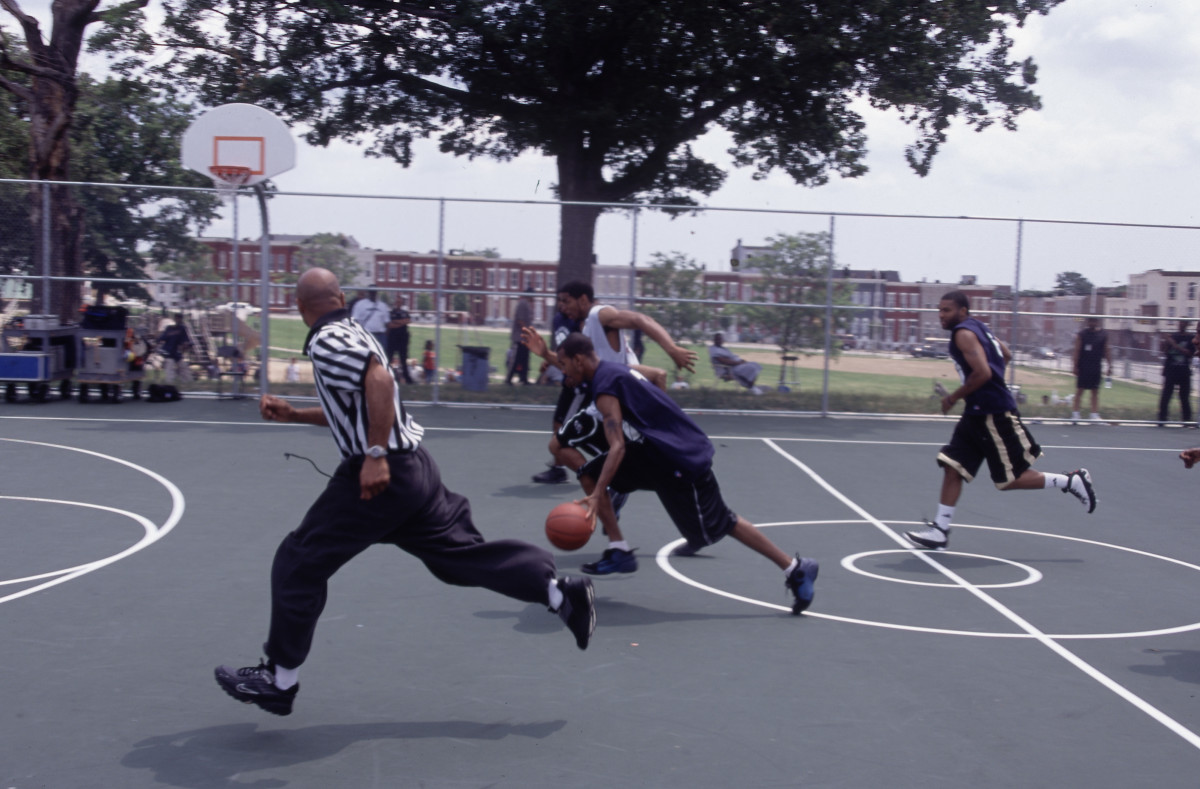
CHRISTOPHER CLANTON (Baltimore native, Savino): The East and West games—those are real.
MAURICE BLANDING (Avon’s ringer): That episode portrayed the basketball—the street life basketball of it, anyway—it portrayed it very, very close to what it was, to be honest. The hustler guys are on the benches, the coaches are on the bench. The players are there. […] I don’t know where they got their information from, but they did a very good job with that episode, as far as how the crowds would be just packed around the court, climbing on the fence. All of that is so on point that it was scary. It made me feel like I was really back playing in the summer league again.
PAT MORAN (Baltimore casting director): If you had 10 scenes where you had 10 lots and just filmed what was going on on the days that they played, you’d never pick that one out as being fake. Never.
ANDRE “SILK” POOLE (Prop Joe’s ringer): Maurice is a west side guy. So it used to be games like that. And the authenticity of that is 1,000%.
MAURICE BLANDING (Avon’s ringer): When you talk about the drug dealers, that is very real. Because you had east side drug dealers, west side drug dealers who would purchase the teams for the summer leagues.
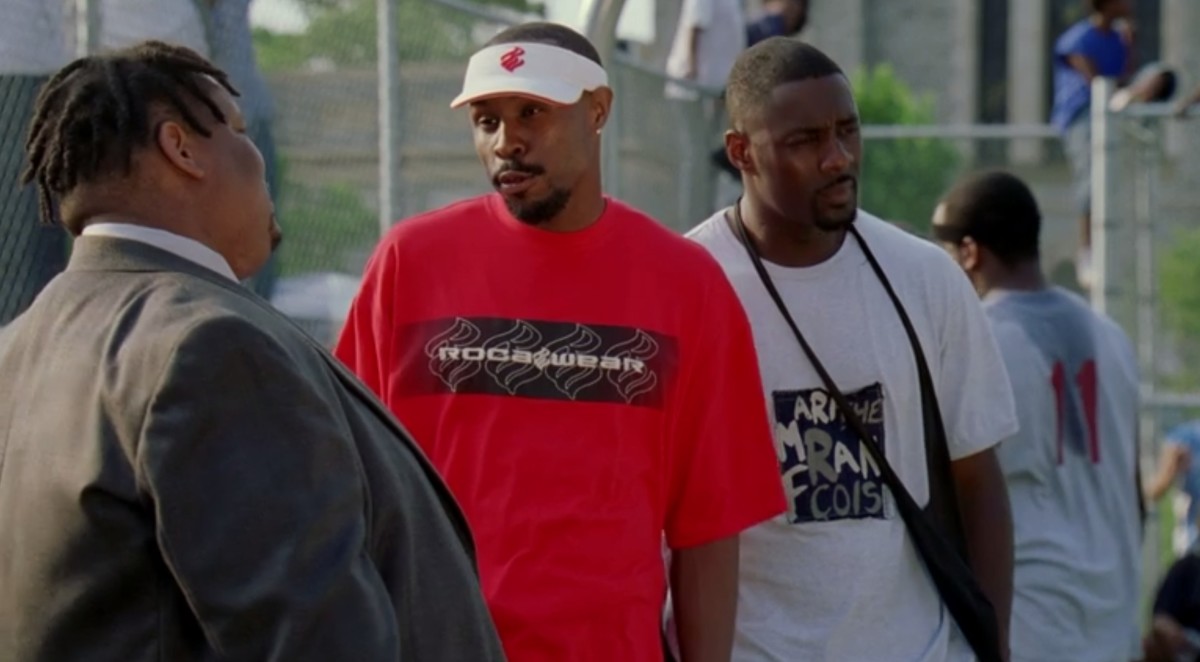
ANDRE “SILK” POOLE (Prop Joe’s ringer): A lot of times it’s just bragging rights. I mean really. Two dudes, they get together, they’re somewhere eating. They get to talking trash: “Oh man, my man Silk this that.” “Well oh man, such and such well we’ll put a team together!” And then it’ll go from there. “Well, bet the money—what you betting?” “Let’s bet five, 10,000.” “Oh that’s all what you want to bet? Let’s bet 30,000!” So it goes from that to that. You’re eating, next thing you know they’re putting together a game in three days with 30, $40,000. And now you got all the other guys: “Oh I’m putting 5,000,” “I’m putting up 5,000 up,” “I’m putting 10,000 up.”
MAURICE BLANDING (Avon’s ringer): They would make sure we had food to eat. Because some of the guys we played with didn’t have a good stable home life. They didn’t have a father figure. They didn’t have a great mother figure.
ANDRE “SILK” POOLE (Prop Joe’s ringer): It’s kind of weird, but the drug dealer guys or the quote unquote bad guys, they always made sure and protected the players. And it’s kind of weird in that kind of world of chaos that it panned out that way. That they always made sure: “Nah, leave them alone. Leave those guys out of this.” You know what I’m saying? Even though we was an intricate tool into what they was trying to do.
Crystal Ball: Who Will Win the 2017 NBA Finals?
CHRISTOPHER CLANTON (Savino): It was funded by them. Of course. But that’s what it was. The Wire touched on so many true topics.
MAURICE BLANDING (Avon’s ringer): I know hustling is not the greatest thing in the world. I get that. But these guys really had good hearts. They did the things they did, and some died and some went to jail. Some stopped hustling and are now working a regular 9 to 5. But back then, it was the way of the world. You had east side teams battling west side teams. Every chance we got to play an east side team, we would stack up our best west side team to go play the east side guys.
PAT MORAN (Baltimore casting director): Those games are big deals. They’re big deals when they go down. Whether it’s the east side against the west side, one neighborhood against another, whatever it is. They definitely always had a lot of people there and they were big deals.
MAURICE BLANDING (Avon’s ringer): I think that was their way of maybe saying hey this is my good deed despite all the bad deeds that I’m doing, hustling and selling drugs. This is my way to give back.
CHRISTOPHER CLANTON (Savino): There’s always a special sense of authenticity with every episode of The Wire. I don’t care what scene you watch. If you’re from Baltimore, you’re able to point out certain things that they hit spot on. With them getting the game—with them organizing and casting who they cast as the players, I believe that’s what made it feel real because they know nothing other than basketball.
BINO RANSON (player): I know you’ve got the Orioles, and you’ve got the Ravens and you had the Colts. But basketball is kind of, especially when you’re talking inner city amongst youth, basketball is sort of like the front porch for inner city. Basketball pulls a lot of people together in Baltimore. There’s a lot of live wires in terms of basketball which connects people.
ANDRE “SILK” POOLE (Prop Joe’s ringer): If you go down the line of Baltimore players, it always starts back from probably the greatest player to come out of here, Skip Wise, to Ernie Graham, to Kurk Lee. You’ve got Carmelo. You go down the line—Juan Dixon, you’ve got Reggie Lewis, Muggsy Bogues, Sam Cassell—all the way down the line. And the thing that Baltimore players always get from any other player? They get the respect.
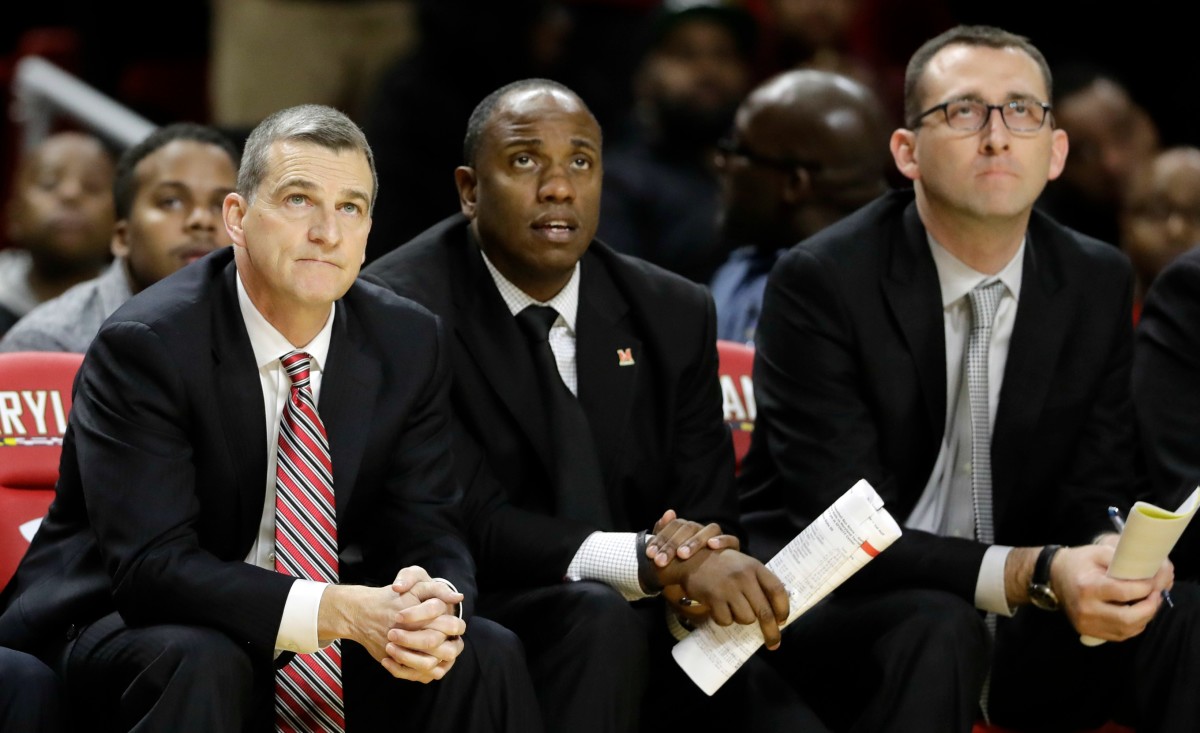
BINO RANSON (now an assistant coach at Maryland): Everybody in the country, every college coach now will come up to me and say was that you in The Wire? I can’t even go on the road or recruiting without somebody saying, “oh I watched TheWire.” Like Matt Painter, head coach of Purdue, he’s a big time Wire fan. And we talked about it. […]
Matter of fact, my son—he even watched it. And he was like “Dad, I saw you in The Wire, Dad! I saw you get hit up!”
MAURICE BLANDING (Avon’s ringer): It really was amazing. They made me feel like I was one of the top actors, and really I was just nobody.
ANDRE “SILK” POOLE (Prop Joe’s ringer): It was a who’s who of basketball. I just happened to be the star that day.
DAVID SIMON (creator): It was a fun day to be an extra. There were a lot of Baltimore faces, which I loved.
MAURICE BLANDING (Avon’s ringer): I think that was the biggest part of why The Wire was so successful—that [David Simon] actually used people who were former drug addicts. That were former basketball players, teachers. Everybody he used from Baltimore probably had their own story. This is just my story. Everybody has a story in Baltimore. Everybody does. Trust me.
